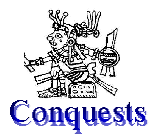|
|

The first concern after the fall of the Tepanec empire in 1428 was to secure the political and economic around the southern lakes. With the help of Netzahualcoyotl, the Mexica conducted successful campaigns against the smaller primarily agricultural centers. These conquests contributed to the future ascendancy of the Mexica. They now began a new plan of a joint expedition across the rim of the Ajusco Mountains. Thousands of warriors were summoned and assembled in squadrons.
The towns conquered were then made to pay tribute to their conquerors. The income from tribute-districts allowed the Aztec rulers to develop impressive courts and palaces, and provided the labor and supplies to carry out building projects. A fabric of private and state-controlled land and tribute organizations formed a criss-crossing web of economic and political relationships. The many levels of these connections enabled the great commanders to control the resources of a vast landscape to distribute goods within their hierarchy, and to consolidate and expand their personal power as well as that of their nations.
Montezuma I succeeded Itzcoatl in 1440. This ruler had a strong history of military accomplishment, yet he understood the need to postpone major armed adventures in order to attend to the problems of administration within lands already subjected.
The centralization of power in Tetzcoco and Tenochtitlan was further consolidated by the promulgation of a "legalist" system, designed to ensure government by severe but standardized laws that favored the rule of the state. Netzahualcoyotl is credited with the creation of this system, which ordered the empire by defining behavior and responsibilities, with punishments to be handed out with supreme impartiality.
|
|

